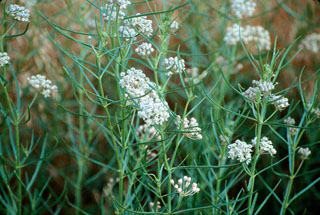POISON MILKWEED
|
 |
| File Size: 176 KB |
|
|
|
Asclepias subverticillata (A. Gray ) Vail
|
| Grant County, Kansas (Marion McGlohon photo) |
| Perennial |
| Height: 1-3 feet |
| Family: Apocynaceae – Dogbane Family |
| Flowering Period: June, July, August |
|
| Stems: | | Plants glabrous to sparsely puberulent in lines, not glaucous; sap milky. Stems Erect, simple or branched distally. | | Leaves: | | Subverticillate or whorled, 3-4 per whorl, with secondary clusters of short leaves in some axils; petiole absent; blade linear, 1.2 to 4.7 inches long, .04 to .16 inch wide, apex acute. | | Inflorescences: | | (1-)2-8, usually axillary, 5-30-flowered. | | Flowers: | | .27 to .3 inch long, .08 to .12 inch wide; calyx lobes narrowly lanceolate to ovate, .05 to .09 inch; corolla white, sometimes tinged greenish purple, lobes reflexed, elliptic, .13 to .18 inch; hoods white, ascending, 1.06 to .08 inch, margins entire, apex rounded; horns acicular, 1.5-2 times as long as hoods, adnate to proximal 1/3 of hoods, arching over anther head; gynostegium stipitate, .08 to .12 inch. | | Fruits: | | Follicles, narrowly spindle-shaped, 2.4 to 3.5(-5) inches long, .2 to .3 inch wide, smooth, puberulent. Seeds ovate, .2 to .3 inch; coma white or tan, .8 to 1.4 inch. | | Habitat: | | Sandy to gravelly shortgrass prairies, roadsides, open floodplains. | | Distribution: | | West fifth of Kansas | | Origin: | | Native | | Toxicity: | | One of our most toxic species of Asclepias and the one causing the most problems for livestock. It is toxic to all animals, including birds, and the toxicity is not diminished when dried, making it a problem in hay (Burrows and Tyrl 2001). | | Comments: | | Asclepias, for Aesculapius, Greek god of medicine, and subverticillata, almost and whorled. |
|
| Poison milkweed habit |  | | 194 KB | | Grant County, Kansas (Marion McGlohon photo) |
| | | | |
|
|
|
|
|
|